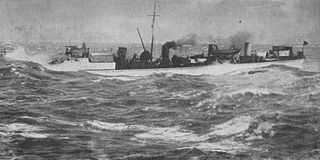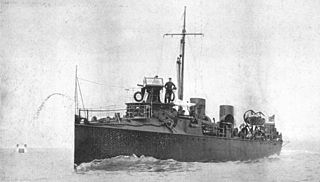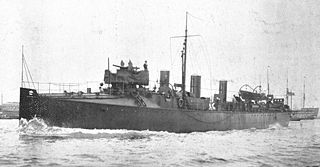
HMS Hornet was a Havock-class torpedo boat destroyer of the British Royal Navy. She was launched in 1893 and sold in 1909 for scrapping. Although the Daring-class torpedo boat destroyers were ordered first, Havock and Hornet were completed faster, making them the first destroyers ever built.

The three Ardent-class torpedo boat destroyers were ordered by the British Admiralty on 12 October 1893 and served with the Royal Navy. Built by Thornycroft for a contract price of £110,520 for all three vessels, they displaced 301 tons fully laden, and were 201 feet 8 inches (61.47 m) long overall.

HMS Ardent was a Royal Navy 27 knot torpedo boat destroyer ordered from John I Thornycroft & Company under the 1893 – 1894 Naval Estimates. She was the sixth ship to carry this name.

The three Charger-class destroyers were all ordered by the British Admiralty on 12 October 1893 and on completion in early 1896 they served with the Royal Navy until 1911.
Two Hardy-class destroyers served with the Royal Navy. HMS Hardy and HMS Haughty were both built by Doxford, ordered on 3 November 1893. They were fitted with 8 Yarrow boilers. They displaced 260 tons, were 196 feet long and were armed with one twelve pounder quick-firing gun mounted forward and five 6-pounder guns, mounted on the broadside and aft, and two torpedo tubes on a revolving mount. They carried 53 officers and men, and served in home waters before being sold off in 1911 and 1912 respectively.
HMS Hasty was a Charger-class destroyer which served with the Royal Navy. She was launched by Yarrow Shipbuilders in 1894, served in home waters and was sold off in 1912.
HMS Hardy was a Hardy-class destroyer which served with the Royal Navy. She was built by William Doxford & Sons in 1895, launched on 16 December 1895, and sold off on 11 July 1911.
Three Janus-class torpedo-boat destroyers (TBDs) served with the Royal Navy. Janus, Lightning and Porcupine were ordered under the 1893-94 Programme, all laid down on 28 March 1894 at Palmer's shipyard at Jarrow and launched during 1895. They displaced 275 tons (light), were 204 feet 6 inches (62.33 m) long and produced 3,900 hp (2,900 kW) from their Reed water tube boilers which gave them a top speed of 27 knots.
The Salmon class were two destroyers built by Earle's to an Admiralty specification for service with the Royal Navy.

The Banshee class was a class of three torpedo boat destroyers that served with the Royal Navy into the early part of the Twentieth century.

HMS Banshee was one of three Banshee-class destroyers which served with the Royal Navy.

Two Fervent-class destroyers served with the Royal Navy.
Two Swordfish-class destroyers served with the Royal Navy. Swordfish and Spitfire were both built by Armstrong Whitworth at Elswick, Tyne and Wear launching in 1895. Fitted with Yarrow boilers, they could make 27 knots and were armed with one twelve pounder and two torpedo tubes.

Three Conflict-class destroyers served with the Royal Navy. All were built by the White Shipyard.

Three Handy-class destroyers served with the Royal Navy. Handy, Hart and Hunter were all built by Fairfield.
Three Rocket-class destroyers served with the Royal Navy.

The Sturgeon-class destroyers served with the Royal Navy from 1894; three were built by the Vickers yard and differed from other similar ships in having their mast stepped before the first funnel. They had Blechynden boilers which gave them 4,000 hp (3,000 kW) and 27 knots. They were armed with one twelve pounder and two torpedo tubes. They carried a complement of 53 officers and men.

HMS Sunfish was a "twenty-seven knotter" torpedo boat destroyer of the British Royal Navy. Built by the Tyneside shipbuilder Hawthorn Leslie, Sunfish was one of three destroyers built by Hawthorns that year. She was sold for scrap in 1920.

HMS Opossum was a "twenty-seven knotter" torpedo boat destroyer of the British Royal Navy. Built by the Tyneside shipbuilder Hawthorn Leslie, Opossum was one of three destroyers built by Hawthorns that were ordered in 1894. She was launched in 1895 and completed in 1896. She remained in service during the First World War, where she was used for local patrol duties based at Plymouth and sank the German submarine UC-49 on 8 August 1918. She was sold for scrap in 1920.

HMS Ranger was a "twenty-seven knotter" torpedo boat destroyer of the British Royal Navy. Built by the Tyneside shipbuilder Hawthorn Leslie, Opossum was one of three destroyers built by Hawthorns that were ordered in 1894. She was launched in 1895 and completed in 1896. She remained in service during the First World War, where she was used for local patrol duties. She was sold for scrap in 1920.












